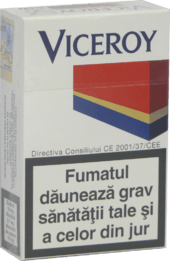Viceroy (cigarette)

Viceroy is a low-cost cigarette brand owned by London-based British American Tobacco. Viceroy cigarettes are made by Brown & Williamson (B&W), an American tobacco company which was bought by British American Tobacco (BAT) in 1927. Viceroys were first produced in 1936; the first filter cigarettes with a cork tip.[1]
Origin
Viceroy originated in the U.S. in 1936, produced by B&W as the world's first cork-tipped filter cigarette. It was a mid-priced brand at the time, equivalent to B&W's Raleigh cigarettes flagship brand, but more expensive than Wings cigarettes introduced by B&W in 1929.[1] In 1952 Viceroy was the first brand to add a cellulose acetate filter which established a new industry standard. In 1953, Viceroy Filter Kings were introduced. In 1990, Viceroy Box Kings and Lights Box Kings were introduced on the U.S. market, followed by Viceroy Ultra Lights Kings and Ultra Lights 100's in 1992.
In the 1970s, Viceroy was proposed as part of a B&W marketing test to see whether children could be encouraged to become smokers. This was discovered by the Federal Trade Commission during a closed investigation of cigarette company advertising practices. The Viceroy ad campaign was not carried out.[2]
The Viceroy brand was involved in public controversy beginning in 1994 when U.S. Food and Drug Administration Commissioner David Aaron Kessler revealed that B&W had been found growing genetically modified tobacco plants in South America, the plants engineered to produce increased levels of nicotine. Viceroy King Size and Viceroy Lights King Size cigarettes made in 1993 were identified as some of the B&W brands carrying "approximately 10% of this genetically bred high-nicotine tobacco called Y-1," referring to Y1 tobacco.[3]
Further controversy came in 1995 when former B&W vice president Jeffrey Wigand, a research chemist, revealed that B&W had been adding chemicals to the B&W cigarette brands Kool, Capri and Viceroy to increase smokers' addiction to nicotine.[1][4]
New Viceroy 100's box styles changed in the 1990s, and Viceroy Menthol was introduced in 2000. All Viceroy styles changed to a more contemporary packaging on packs and cartons without changes to the product blend.
Modern brand
On July 30, 2004, parent company Reynolds American Inc. was formed as a joint venture between the U.S. branch of BAT and R.J. Reynolds Tobacco Company. The Viceroy brand was brought under the Reynolds American umbrella as a part of B&W under RJR Tobacco.[5]
After the B&W merger, the Viceroy brand has been played down in the U.S., continuing to be sold on the markets where demand is strong, like Russia, Poland, the Czech Republic, Argentina, Romania, the Middle East, Turkey and Chile.[6] Viceroy Red and Blue are sold as a budget brand in Canada.
Canadian musician Mac DeMarco recorded a song about the brand, entitled "Ode to Viceroy" on his album 2.
See also
References
- 1 2 3 Cox, Jim (2008). Sold On Radio: Advertisers in the Golden Age of Broadcasting. McFarland. pp. 102–103. ISBN 0786433914.
- ↑ Brenner, Marie (May 1996). "The Man Who Knew Too Much". Vanity Fair: 4.
- ↑ Kessler, D. A. (1994). "The control and manipulation of nicotine in cigarettes" (PDF). Tobacco Control. 3: 362–369. doi:10.1136/tc.3.4.362. PMC 1759375
 .
. - ↑ "Deposition of Jeffrey Wigand, Ph.D.". Legacy Tobacco Documents Library. University of California, San Francisco. November 14, 1996. Retrieved November 20, 2012.
- ↑ Cox 2008, p. 231
- ↑ "Our international brands". British American Tobacco. Retrieved November 20, 2012.
External links
- Viceroy commercials compilation (1964)
- Viceroy commercial compilation (1968) part 1
- Viceroy commercial compilation (1968) part 2

